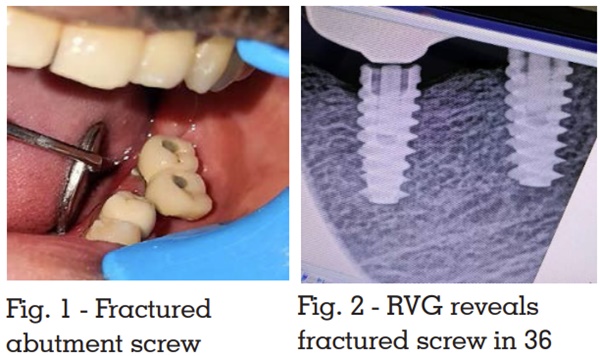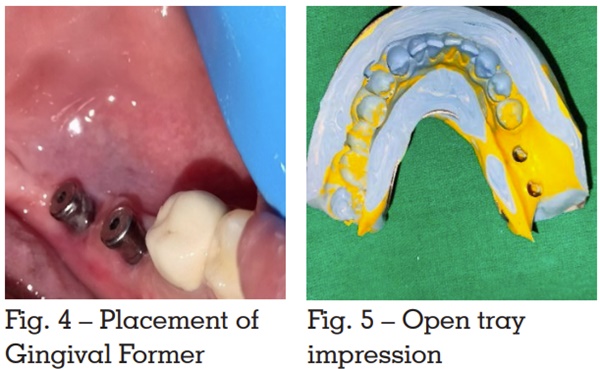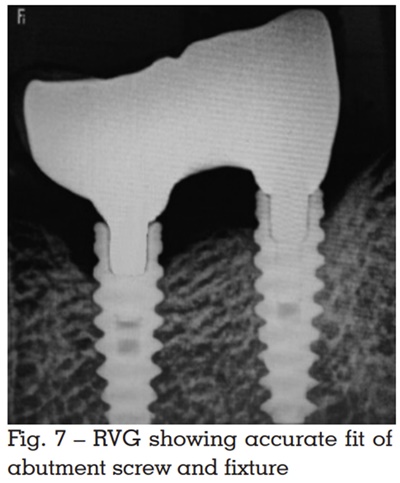

In an abutment - implant fracture, it is generally a challenge for the clinician to remove the fractured fragments. A fractured abutment screw of a single crown or fixed dental prostheses supported by an endosseous implant is a complication. In some cases, the screw cannot be removed, and alternative solutions should be considered. This clinical report describes a fractured abutment screw prostheses and cold welded screw, which was impossible to retrieve.
Key words: Dental implant, Implant abutment screw fracture, over load, Implant abutment screw retrieval
Dental implants are an effective, reliable, and
predictable prosthodontic treatment option for
partially and completely edentulous patients.1,2
Despite a high success rate of 97% to 99%,3,4
technical and biological problems may be
encountered. Biological complications include
peri-implant radiolucencies, peri-implantitis, and
radiographic signs of loss of osseointegration.
Technical complications include loss of retention,
screw loosening, and fractures of porcelain/framework/screws.5
Abutment screw fracture is an uncommon (range
from 0.5% to 8%)6
but challenging the technical
complication in implant-retained restorations
and may occur due to bruxism, unfavorable
superstructure, overloading, malfunction,
premature occlusal contacts, metal fatigue after
screw loosening, and component misfit.6-9
Dental implants have been a life enhancing
modality for partially and completely edentulous
patients. Implants can successfully support a
cemented or screw retained single crown. However,
this modality is not without complications. A
fractured abutment screw may occur after the
prosthesis is under functional cyclic loading. The
abutment screw may be overloaded and fracture
leaving the abutment and coronal screw fragment
inside the abutment/crown and the apical fragment
in the fixture itself. Abutment screw fracture is a
rare event, occurring less than 0.5 %.10
Occlusal loading is a multi-directional and variable
magnitude force. Even though an integrated
implant transmits the load to the surrounding
bone, the load is transmitted through the abutment
and its retaining screw. The abutment screw will receive tensile and bending moments that can
induce a fatigue fracture.10, 11
There are several techniques for managing a
fractured abutment screw. These include removal
and retreatment of screw and prostheses, followed
by re-fabrication, screw fragment retrieval and
other techniques.12,13 Many but not all implant
companies offer fracture screw removal kits
but they are expensive and do not consistently
remove the fracture segment. Case reports and
a technique for abutment, fragment retrieval and
crown-abutment separation and re-cementation
of the crown and over-denture retainer fracture
are discussed herein.
A 25 year old male patient reported to the
Department of Prosthodontics, with the chief
complaint of loosening of implant crown prostheses in lower posterior region. Past dental history
revealed that patient had undergone implant
placement in lower left back tooth region 3 years
before with screw retained prostheses. On intraoral
examination, there was a fractured abutment
screw in 36 region and screw loosening in 37 region
(Fig 1). RVG revealed fractured implant abutment
screw in 36 region with well osseointegrated
implant (Fig 2).


The screw retained crown prostheses is removed
and the fractured screw was removed by using
ultrasonic scaller tip. (Fig 3)
After the removal of prostheses, gingival former
was placed on 36 and 37 region to guide the
healing of soft tissue. (Fig 4).

Impression copings was placed and closed tray
impression were made for the fabrication of new
abutment screw with the same existing crown
prostheses (Fig 5).

The new screw retained prostheses was fabricated
with the existing crown and the fit was checked
intraorally along with occlusion (Fig 6). The access
hole of final screw retained prosthesis was filled
with putty material and flowable composite
resin. RVG is made to check the accurate fit of
the abutment screw and implant fixture (Fig 7).

A common complication of implant prosthetics is
with components. The abutment screw connects
the abutment to the fixture and can fracture
under occlusal functional load. In preparation
for treatment of a patient presenting with an
abutment screw fracture, a radiograph should be taken to insure osseous support quality of
the supporting implant. In this case report, the
fractured implant abutment screw is managed by
use of simple method by using ultrasonic scaler tip.
The conservative approach in the management of
abutment screw fractures is to retrieve the fractured
screw to facilitate the reuse of the implant. When
an abutment screw fractures above the implant
body, the fractured screw is grasped with a
hemostat, or a sharp explorer is used to remove
it with a counter clockwise motion.14,15 If the
abutment screw fracture occurs within the body
of the implant, retrieving the screw fragment will
be more challenging. A modified spoon excavator
can be used to engage the fractured screw after
making a groove on it. The working end of the
spoon excavator is cut perpendicularly to engage
the groove on the fractured fragment.
Although clinicians can use various techniques
to remove fractured abutment screws, every
effort should be made to eliminate the cause
of screw fracture. Conservative techniques are
to be advocated initially before considering
the use of commercial retrieval kits. Retrieval
of the broken screw fragment should be done
judiciously to prevent any internal damage to the
implant structure. More clinical research should
be conducted to determine the effectiveness of
various techniques in the retrieval of fractured
abutment screws.